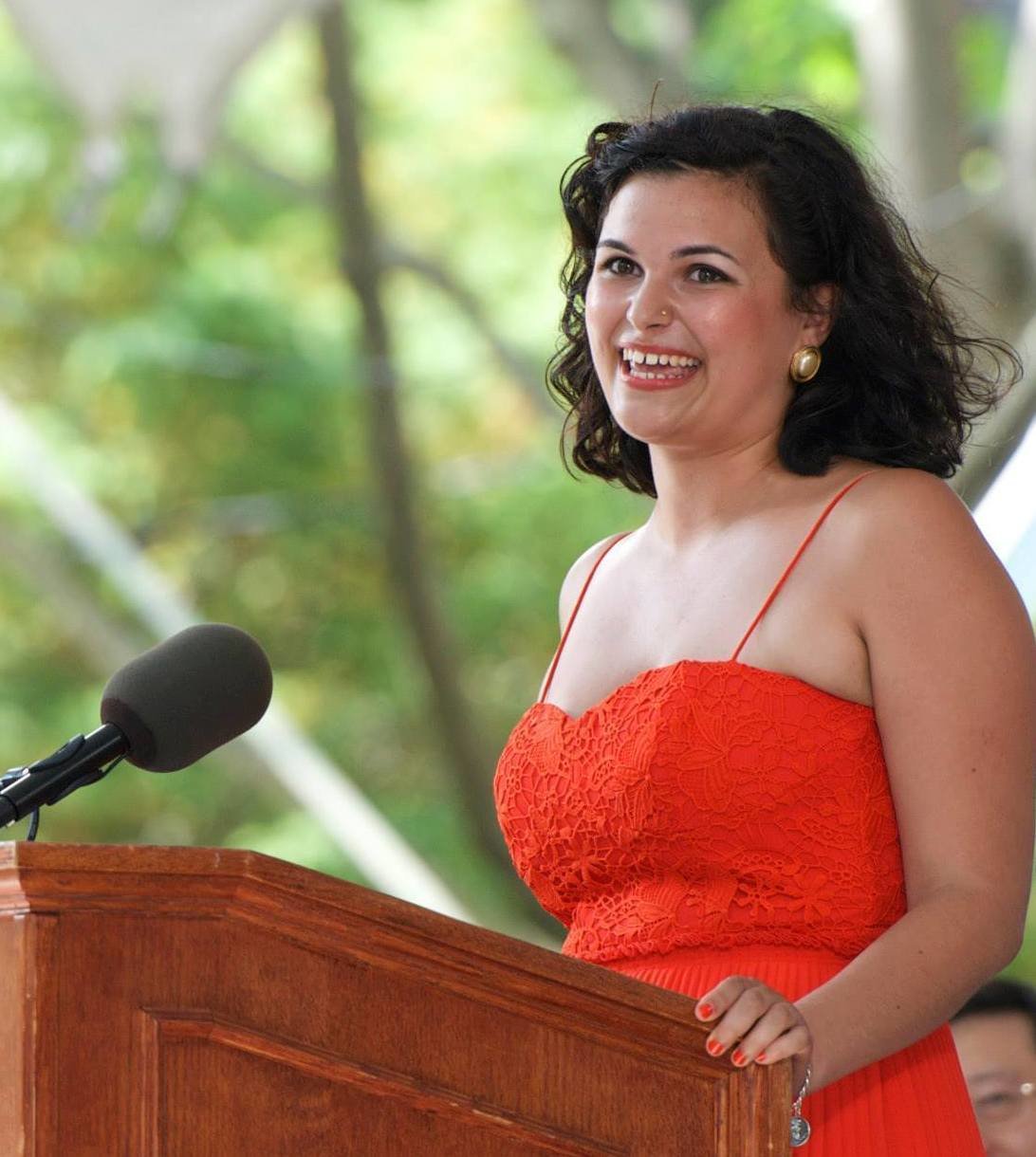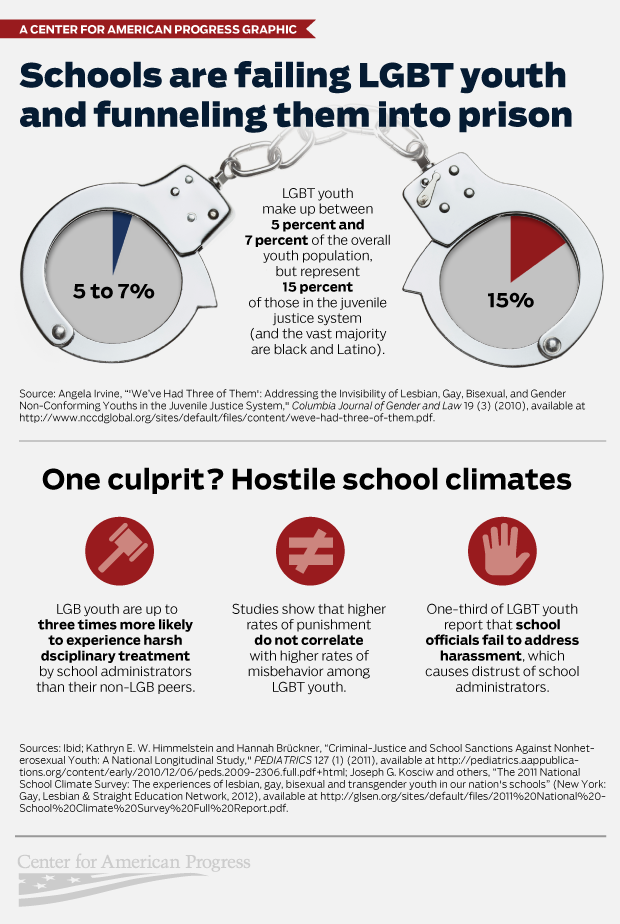Why Are There so Many LGBT Youth in Prison?

By:
For the thousands of LGBT youth in the American juvenile justice system, bullying is just the beginning. That’s because, while lesbian, gay, bisexual, transgender, and gender nonconforming (GNC) youth makeup five to seven percent of young people in America, they are 15 percent of young people in the juvenile justice system.
Low-income youth and youth of color are also particularly affected: a shocking 60 percent of the LGBT youth arrested and/or detained each year are Black or Latino. Factors ranging from family rejection to school discipline to homelessness—each exacerbating the other—increase LGBT and gender nonconforming youth’s risk of being funneled into the juvenile justice system.
 Center for American Progress - americanprogress.org
Center for American Progress - americanprogress.org
Once there, bullying and harassment, discrimination, and harsh punishment conspire to keep kids in a vicious cycle, as harassment and excessive discipline leads to trauma, missed school, and potentially higher rates of recidivism.
“All of what we would consider feeders into the juvenile justice system, queer and trans youth are disproportionately represented in,”Wesley C. Ware, Co-Director of BreakOUT! told ATTN. The New Orleans-based organization is dedicated to fighting the criminalization of LGBT youth at a grassroots level.
Too often, LGBT kids are criminalized for being victimized, for expressing themselves, or for just being teens.
“In general, the juvenile justice system criminalizes normal adolescent behavior, period, and I think that amplifies for LGBT [teens],” said Christina Gilbert, Director of the Equity Project, an initiative examining issues affecting LGBT youth in delinquency court.
Keeping LGBT kids out of the juvenile justice system requires considering their lives in context and supporting, rather than stigmatizing, their identities.
Lack of Family Support
For many LGBT and gender nonconforming kids in the juvenile justice system, lack of support begins at home.
One study found that 45 percent of parents felt angry or disgusted about their child’s sexual orientation, while another found that 30 percent of LGBT young people experienced anti-LGBT familial physical abuse. Families upset by their child’s gender identity or sexual orientation may have the youth charged with “ungovernability,” or “incorrigibility,” claiming that the child has become impossible to control just because they are LGBT.
For children already in the system, they may be subject to family members’ anti-LGBT rules as a condition of probation or parole.
“One of the number one problems that LGBT youth have is that when they’re home, or on probation, they have some conditions of release; one of the conditions is to obey home rules,” Vickie Henry, Youth Initiative Director and Senior Staff Attorney at Gay and Lesbian Advocates and Defenders (GLAD), told ATTN.
What happens when parents order that their transfeminine child (someone assigned male at birth but identifies as female) should only wear boys' clothes? Then that child’s act of self-expression becomes a potential parole violation.
“The parents can think whatever they want, but the system shouldn’t enforce that prejudice,” Henry said. “They should not say, 'We’re going to revoke your release or your probation because you haven’t respected the rules that your parents have set down 'if those rules violate the youth’s sexual orientation.”
Family rejection often translates to LGBT youth getting kicked out or running away from home—the greatest predictor of LGBT youth involvement in the juvenile justice system.
Many LGBT and gender non-conforming young people are thus forced onto the streets, with little to no access to shelters, where nonviolent “survival crimes” like petty theft and sex work lead them into the juvenile justice system.
“They’re kicked out, and then commit crimes to support themselves,” Henry said.
The School to Prison Pipeline
For many LGBT and gender nonconforming youth who are discriminated against at home, school promises a safe haven. Yet all too often, peer and adult bullying, discriminatory disciplinary procedures, and “zero-tolerance policies” increase these students’ risk of entering the juvenile justice system.
“LGBT youth are more likely to be pushed out of school, more likely to be arrested from school” than their non-LGBT peers, Ware, of BreakOUT, said.
Much attention has been devoted to the issue of peer LGBT bullying in schools, which according to an Equity Project report, 86 percent of LGBT youth report. Those surveyed cited verbal harassment from peers because of their sexual orientation, while 67 percent report harassment about gender expression. Forty-four LGBT youth reported physical harassment (either pushed or shoved) due to their sexual orientation or and 30 percent because were harassed because of gender expression.
Harassment is so pervasive, one report found that 32.7 percent of LGBT students had missed one or more days of school in the past month due to bullying.
Yet equally, if not more detrimental for LGBT youth, is harsh treatment from adults. In one study, almost half of LGBT youth reported they were called offensive names by teachers. LGBT youth are also at a high risk for unfair punishment and are almost three times more likely than their non-LGBT peers to be harshly disciplined by school staff. This is especially the case for gender non-conforming girls.
The implementation of “zero tolerance” policies often encourage suspension or expulsion for minor offenses, or replace normal school staff with police - a practice found to increase student entrance into the juvenile justice system.
“For a long time, education advocates and well-intentioned LGBT advocates were very concerned around bullying in schools, and what that led to was zero tolerance policies,” Ware said. “Now a number of organizations are opposed to zero tolerance policies because what we found is that queer and trans youth were being kicked out of school.”
This hostility motivates many LGBT students to avoid school, leading to charges of truancy and entrance into the juvenile justice system—in the case of students already in the system, it could mean parole violations.
“If a kid is on probation for truancy or something like that, and if one of the conditions of their probation is going to school, all of a sudden they can get locked up” for avoiding school, Gilbert said.
Efforts toward Reform
Support—not criminalization—for LGBT youth calls for reform on both the policy and community level.
At a policy level, experts call for non-discrimination measures that explicitly mention gender identity and sexual orientation as protected categories in schools, courts, and juvenile detention facilities. They also call for training of juvenile justice personnel at all levels of the juvenile justice system itself.
In schools, LGBT-specific nondiscrimination and anti-bullying policies should be accompanied by increased access to LGBT-specific resources and information, elimination of police presence, and a shift from excess discipline to positive behavior interventions, according to the Center for American Progress in their 2014 report, “Beyond Bullying.”
But to fully address the factors that hurt LGBT kids, Ware said, communities need to take the lead.
“The best alternatives, really the only true alternatives, are community-based, so operated by folks in the community, not run by probation or not run by the district attorney’s program,” Ware said.
Ultimately, for Ware, the best intervention starts with LGBT kids themselves.
“Young people are experts on their own lives,” Ware said. “It’s about listening to young people when they tell us what they need.”
